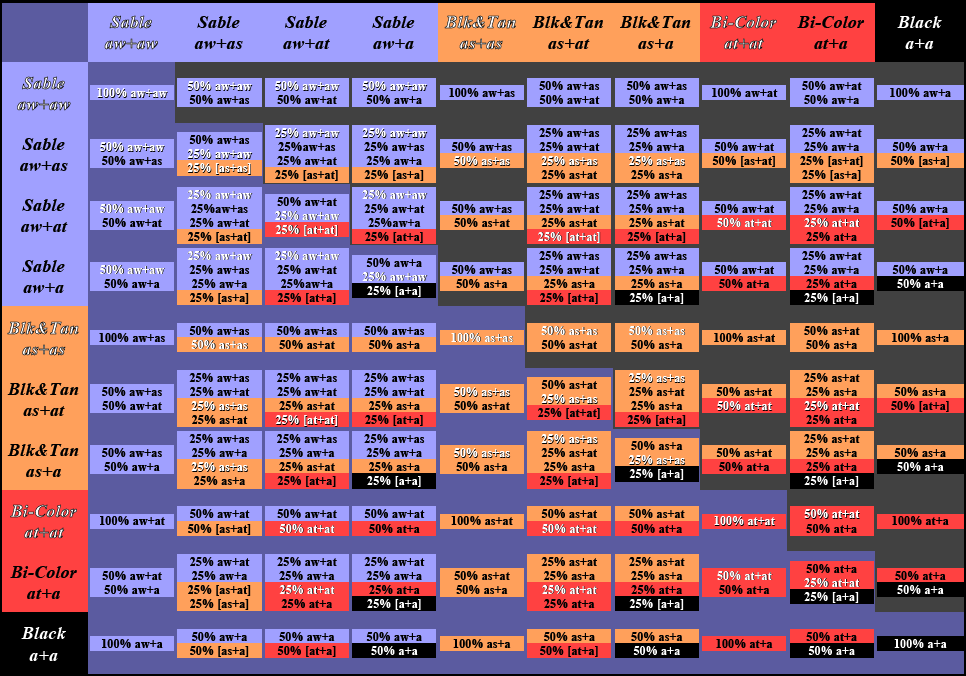
This is a placeholder text
Group text
by yellowrose of Texas on 03 August 2010 - 17:08
38 pairs of shoes!
I have more than that !
LOL
FHTracker I did learn a few things on that link!
YR
by BlackthornGSD on 03 August 2010 - 19:08
Christine
by gagsd4 on 03 August 2010 - 19:08
Recessive (black) means that they carry no other color, because if they did they would be that other color, not the recessive color.
If you breed two dominants, the possibilities are not endless. They would only produce what the "hidden" gene is.
Sable(carrying blk/tan) bred to Sable(carrying black) could produce sable, black, or blk/tan. No Bi-colors (although MANY breeders mistakenly dub dark puppies bi-colors).
edited: sable(blk/tan) bred to sable(black) can only produce sables and blk/tans, no blacks.
---Mary
by pod on 03 August 2010 - 20:08
ARRHG NO! There are mistakes on that page, and it's well out of date. It's only going to add to confusion.
Try this one - http://bowlingsite.mcf.com/genetics/colorgen.html
by darylehret on 04 August 2010 - 01:08
For the gene location (agouti locus) that controls the basic coat patterns that are accepted by the current breed standard, there are two alleles, and the most dominant of the two describes the dog's actual color. When the parents are bred, each parent contributes either one, but only one, of their pair from the agouti locus. Thus, the offspring inherits one allele from each parent, to form an allele-pair (genotype) of its own. The result is a combination that can sometimes express a coat type (phenotype) that neither parent has in appearance.
This is the order of dominance, each being "recessive" to the gene listed prior to it
Sable gene = "aw"
Black & Tan gene = "as"
Bi-Color gene = "at"
Black gene = "a"
The possible genotypes for...
a Sable dog ("aw" most dominant of the pair)
aw+aw
aw+as
aw+at
aw+a
a Black & Tan dog ("as" most dominant of the pair)
as+as
as+at
as+a
a Bi-Color dog ("at" most dominant of the pair)
at+at
at+a
a Black dog ("a" most dominant of the pair)
a+a
Below are the "probabilities" that result from two given genotypes when mated...
Homogenous genes are a "fixed type", designated in white lettering
Latent genes that have resurfaced expression previously hidden by the phenotype of the parents are designated with brackets
If you want to print a copy of this chart http://www.ehretgsd.com/GSDcolorGenes.pdf

As LadyFrost mentions, these are merely probabilities. If you bred two sable parents who each had a black recessive, you may very well get twelve black pups and no sables at all, despite the expected 25% black and 75% sables. A repeat breeding would perhaps lean toward heavier than 25% blacks later on.
Averages are not universal laws however, and epigenetic influences can potentially skew those results, which may range from a number of external causes such as physical conditioning, mental stress, dietary, and more, as to which of the parent's allele-pair contribution thrives.
The blocks that are valued at 100% are however safely assumed to remain 100%, barring any spontaneous mutation or genetic transcription error toward a more recessive form, or reverse mutation to the original wild-type (which is sable).
by Steve Schuler on 04 August 2010 - 03:08
Excellent Chart, Daryl!
Thanks for making it available!
SteveO
by darylehret on 04 August 2010 - 04:08

by Sugarplum on 04 August 2010 - 07:08
by Sock Puppet on 04 August 2010 - 07:08
by Sugarplum on 04 August 2010 - 08:08
Contact information Disclaimer Privacy Statement Copyright Information Terms of Service Cookie policy ↑ Back to top





